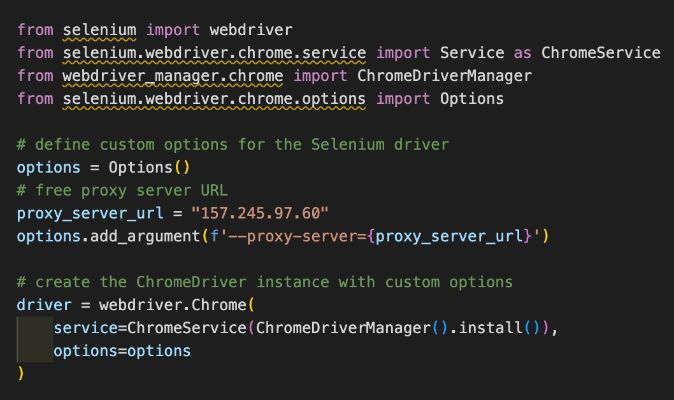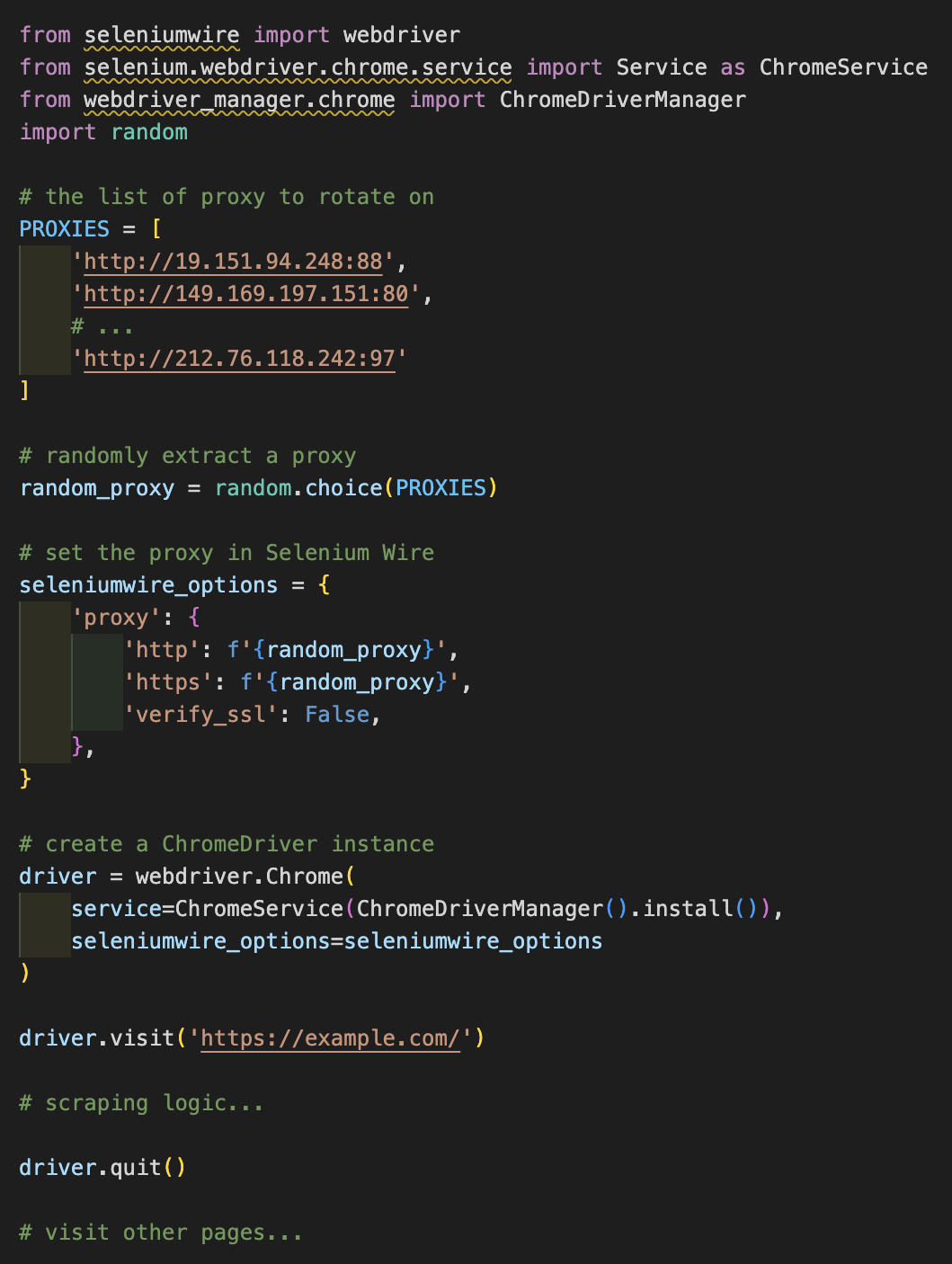

Updated · Feb 11, 2024
Updated · Nov 16, 2023
Raj Vardhman is a tech expert and the Chief Tech Strategist at TechJury.net, where he leads the rese... | See full bio
Girlie is an accomplished writer with an interest in technology and literature. With years of experi... | See full bio
A regular proxy server is usually sufficient for light tasks. However, a need for advanced types arises occasionally.
For instance, you will need proxies for web scraping and other data-gathering projects. Rotating proxies are the best type for that job.
When scraping large files, rotating proxies help you avoid IP bans effectively. You can send multiple requests many times, each looking like they’re from different users.
Proxy rotation is possible with various tools. However, doing it in Selenium Python has more benefits.
Luckily, this guide will show you how to do that—so keep reading!
|
🔑 Key Takeaways
|
Rotating proxies in Selenium Python involves technical steps, which seems daunting for beginners. Nonetheless, it gets easy once you know the process.
Below, you'll find everything you need to know to rotate proxies in Selenium Python.
To rotate proxies in Selenium Python, you will need the following:
|
Requirement |
Description |
|
Python’s latest version |
|
|
Automates web browser interaction from Python |
|
|
Selenium works best with Chrome, so make sure to download the newest version. |
|
|
Proxy list |
All proxy types work in this process. |
|
This extension lets you create multiple requests from a Selenium browser. |
|
✅ Pro Tip TechJury recommends using trusted residential proxies since this type lets you use real IP addresses. You can send multiple requests and make it look like each one comes from a different user. |
Here's a guide on how to rotate proxies in Selenium Python:
Before starting with the whole process, make sure your system supports Python 3 and Selenium. You can do a test by running this code in your source code editor:

If your system has the latest version of Python, the reply will show:

It can be higher by the time you're reading this. Nonetheless, you can proceed as long as it shows Python 3.
Suppose the response indicates an error or Python 2 (or lower), head to Python’s official site and download the latest version.
Once you have the latest version of Python, open a new project using your code editor. Then, add the Selenium Binding Package through this command:
![]()
After installing Selenium, add Python's WebDriver Manager package using this command:
![]()
This package lets you have efficient driver management, so you won’t have to download a ChromeDriver whenever your browser receives updates.
The Python and Selenium packages you installed on the code allow you to control the browser using Selenium.
Use this command to install the needed tools to start the WebDriver function and go to a target:

This step marks the completion of setting up Selenium Python. The following actions will use the finished setup to work with proxies.
In this step, you need a reliable proxy server in Chrome before visiting your target.
As soon as you get your hands on a proxy, copy the proxy server URL. Then, add it to Selenium using this command:

Chrome will import requests using the proxy address. After running the code, go to http://httpbin.org/ip. Make it your target page through this command:

This site will reply with the IP address of the request. With it, you can check whether the proxy you used works.
You can also get the JSON value like this:

Once done, you can put all the code together. Altogether, it should look like this:

If it works, the reply should be:

After configuring Selenium Python to use a proxy, you can use more codes to support rotation.
Rotating proxies in Selenium Python uses Selenium Wire, and here's how to do it:
From your pool of proxies, list the ones you'll use in a set that looks like this:

|
📝 Note If your proxy pool comes from free proxy sites, expect only a few of them to work. You'll have a higher success rate with paid services since they're more secure and reliable. |
Once your proxy list is ready, take one proxy using the random choice command:

This command will start a new driver instance that looks like this:

Once done, you can start browsing with a random IP rotation. However, keep in mind that you must repeat the process for every page you visit.
Although affordable, free proxies often come with safety issues. They lack encryption and might infect the device with malware.
This is why most paid proxy servers require authentication to improve user security. You can also do that to the proxy that you’re using.
If you want to lay out a username and password with a proxy URL in Selenium, follow the format below:
![]()
|
✅ Pro Tip This URL type will not work in Chrome drivers since they ignore the process. Use Selenium Wire instead. |
You can install this plugin the same way we did earlier with proxy rotation:

After that, use the plug-in to deal with proxy authentication using this code:

You may encounter Error 407, which occurs when users enter the wrong credentials. Make sure that your proxy URL uses valid authentication.
Both Python and Selenium are useful open-source tools. They both have the same principle as tools for rotating proxies. However, in some ways, they are also different from one another.
Python is a programming language that creates codes or functions. With it, you can set a proxy pool to rotate based on your preferred intervals.
By rotating proxies in Python, you can:
On the other hand, Selenium is a tool used for automation testing. It's a tool that can work alongside Python to do automatic tests for browsers and web apps.
Rotating proxies in Selenium Python lets you:
Overall, a rotating proxy in Python is more suitable for general use. It's also ideal if you're working with free proxies. The output is also best for tasks that don't need authenticated proxies.
Meanwhile, rotating proxies in Selenium Python are more browser-based. They are best for web scraping and automated scraping.
Rotating proxies offer plenty of advantages to their users. To name a few, here's a list of benefits of rotating proxies:
Sending unique requests

Users who send multiple requests to a target site can get blocked due to suspicious activity. If a site detects an unusual amount of requests, it might treat the requests like spam.
This problem is fixed by rotating proxies since you'll have a different IP for every request. As a result, you can send plenty of requests like they're coming from unique users.
Avoiding trackers

Most sites track IP addresses—for marketing and other purposes. Though most trackers are harmless, there are still a few that can compromise a user’s security.
You can avoid the trackers using with rotating proxy since you’re given a different IP for each request. This lets you enjoy better anonymity and security while browsing the web.
Skipping CAPTCHA and Other Anti-Bots

CAPTCHA and other anti-bots occur when users send multiple requests to a site. While these features are a minor issue, they can still be a hassle for data scrapers.
However, with a rotating proxy, you can avoid them since you're browsing with a unique IP every time.
Other than the benefits above, rotating proxies are also used in:
Rotating proxies in Selenium Python is essential for web scraping and other tasks. With those, users can send many requests multiple times as if each comes from a different user.
With this guide, setting up a rotating proxy in Selenium Python becomes simpler. Thus, enjoy more anonymity, security, and accessibility than what a typical proxy provides.
You can set parameters in the settings through a manual proxy setup. A manual configuration lets you add parameters like IP addresses and port numbers.
The three general types of proxies that prevent web threats are VPNs, web proxies, and CDNs.
Rotating proxies is legal as long as your country allows the use of anonymity tools. Also, using one only remains legal if you're not using it to do any illegal activity.
Your email address will not be published.
Updated · Feb 11, 2024
Updated · Feb 11, 2024
Updated · Feb 08, 2024
Updated · Feb 05, 2024



